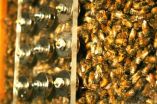(Press-News.org) Deleting the receptor, not the protein ghrelin itself, turns up the body's fat-burning thermostat, giving aging mice an exothermic boost toward a svelte physique, researchers reported at the American Society of Cell Biology's 50th Annual Meeting in Philadelphia.
The protein's receptor, growth hormone secretagogue receptor (GHS-R), might make a better target than ghrelin for treating obesity, according to Yuxiang Sun, M.D., Ph.D., of the Baylor College of Medicine in Houston, TX.
Sun said that experimentally deleting the receptor from the body cells of laboratory mice prevented obesity by diminishing white adipose tissues and activating brown adipose tissue, thereby increasing heat production.
The new finding that ghrelin may not be as critical to energy expenditure as its receptor, GHS-R, came from research on body temperature regulation at Baylor, Sun explained. GHS-R acts as the "lock" for the "key-like" ligand ghrelin to dock; GHS-R subsequently activates down-stream metabolic signal pathways.
With colleagues from Baylor and other institutions, Sun created two sets of genetically modified mice: one was null for ghrelin, while the other group was null for GHS-R. When challenged by cold and fasting, only the mice without GHS-R maintained a normal body temperature.
Intrigued by this finding, the researchers generated two additional cohorts of these knockout mice -- a young group 3 to 4 months old and an older group 10 to 12 months old −− to determine whether obesity and physical activity levels were influenced by age.
The scientists compiled a complete energy metabolic profile for each mouse, charting the animal's food intake against energy output. The energy profiles revealed that neither food intake nor activity levels differed in the gene-deleted mice compared to normal mice, regardless of age. But the GHS-R null mice were thinner because they were more exothermic.
Like aging humans, aging mice gain weight by accumulating fat. In contrast, the older GHS-R null mice maintained a lean physiological profile with lower circulating lipids and exhibited the high-energy expenditure levels that characterized the young mice.
These older GHS-R null mice weren't more active. However, without extra effort, they burned as heat more calories and fat. Meanwhile the older ghrelin-deleted mice followed the pattern of obesity in normal again mice: growing older and fatter.
In the ghrelin-deleted and the GHS-R deleted mice, the researchers then compared levels of UCP1, an "uncoupling protein" known as a hallmark regulator of thermogenic functioning in brown fat.
Consistently UCP1 was significantly higher in the brown fat of GHS-R deleted mice than in the ghrelin-deleted mice. The brown fat of the older GHS-R deleted mice included a higher proportion of smaller fat droplets, an indication of enhanced heat production, said Sun.
The 1999 discovery of ghrelin's role in appetite and energy balance ignited hopes that it was the body's long-sought hunger thermostat. Ghrelin remains the only circulating peptide known to stimulate appetite and promote obesity in both humans and rodents, but it also plays other roles in regulating growth and metabolism.
"All this shows the complexity of ghrelin and its signaling pathway, and suggests the existence of additional unidentified regulators mediating the effect of ghrelin and/or GHS-R," said Sun.
INFORMATION:
FOR MORE INFORMATION:
ASCB contacts:
Cathy Yarbrough
sciencematter@yahoo.com
858-243-1814 (cell)
215-418-5306 (Dec. 11-16)
John Fleischman
jfleischman@ascb.org
513-929-4635 (before Dec. 11)
513-706-0212 (cell)
Baylor College of Medicine contacts:
Yuxiang Sun, M.D, Ph.D.
713-798-7167
yuxiangs@bcm.edu
Dipali Pathak
Communications Specialist
713-798-4712
832-605-2987 (cell)
Sun will present, "Ablations of ghrelin and ghrelin receptor exhibit differential metabolic phenotype and differential thermogenic gene expression in brown adipose tissue," Monday, Dec. 13, 2010, 1 -2:30 p.m., in Aging and Aging-Related Diseases, Exhibit Halls A/B/C, Program 1717,Board B1240.
Co-authors:
Xiaojun Ma, Ligen Lin, Marta Fiorotto, Yuxiang Sun, Baylor College of Medicine Houston, TX; Guijun Qin, Internal Medicine, First Affiliated Hospital of Zhengzhou, China; and Vishwa D. Dixit, Pennington Biomedical Research Center, Louisiana Sate University System, Baton Rouge, LA
Funding:
This study was supported by USDA/ARS CRIS fund, ARS 6250-51000-055 and NIH/NIA grant 1R03AG029641-01.
END
Long considered a freewheeling loner, the Trypanosoma brucei parasite responsible for African sleeping sickness has revealed a totally unexpected social side, opening a potential chink in the behavioral armor of this and other supposedly solitary human parasites, according to research presented at the American Society for Cell Biology's 50th Annual Meeting in Philadelphia.
"The concept of bacteria acting as groups of cells communicating and cooperating with one another has had a major impact on our understanding of bacterial physiology and pathogenesis, but this paradigm ...
Small details between "in vivo" and "in vitro" studies make for big differences in understanding diabetes and other secretory dysfunctions
Exocytosis, the fundamental process by which cells secrete hormones such as insulin and other useful biological substances, is regulated far differently in life than in laboratory tissue cultures and explanted organs, according to research presented today at the American Society of Cell Biology's 50th Annual Meeting in Philadelphia.
The unexpected findings that exocytosis regulation "in vivo" is not the same as the process long studied ...
Researchers have provided the first thorough mechanistic account of how a genetic defect leads to malignant hypothermia (MH) and central core disease (CCD), rare genetic skeletal muscle disorders. The study appears in the January issue of the Journal of General Physiology (www.jgp.org).
Mutations in the type 1 ryanodine receptor (RYR1), the calcium release channel of the sarcoplasmic reticulum (SR) activated during skeletal muscle excitation-contraction (EC) coupling, give rise to CCD. One of the most common CCD-causing mutations is Ile4895Thr. Now, Robert Dirksen (University ...
ST. PAUL, Minn. – Many people with incurable brain tumors use alternative therapies, such as taking vitamins and homeopathy, in addition to their conventional treatments, according to a study published in the December 14, 2010, print issue of Neurology®, the medical journal of the American Academy of Neurology.
About 40 percent of brain tumor patients in the study used alternative therapies including homeopathic remedies, vitamin supplements and psychological therapy.
"The use of these alternative treatments may be largely overlooked and underestimated," said study ...
Folic acid can reduce birth defects including neural tube defects, congenital heart disease and oral clefts but some speculate high intakes of folic acid may be associated with adverse events such as colorectal cancer, states an article in CMAJ (Canadian Medical Association Journal) (pre-embargo link only) http://www.cmaj.ca/embargo/cmaj100568.pdf.
This study, conducted by researchers at Children's Hospital of Eastern Ontario Research Institute and The Hospital for Sick Children, is the first of its kind in more than three decades, to examine the folate status of Canadians ...
Disease-management programs, which may include patient education, psychological intervention, dietary education, self-monitoring and telemedicine, can improve diabetes care, states an article in CMAJ (Canadian Medical Association Journal) (pre-embargo link only) http://www.cmaj.ca/embargo/cmaj091786.pdf.
The study, by French researchers, included 41 randomized controlled trials published between 1990 and 2009 with a total of 7013 patients.
The findings showed that disease-management programs are more effective than usual care in reducing glycated hemoglobin levels ...
VIDEO:
This movie spotlights one waggle dance by a forager that had been sleep-deprived the
previous night. The average dance angle of this dance is superimposed over the dancer and variance around...
Click here for more information.
AUSTIN, Texas—In the busy world of a honey bee hive, worker bees need their rest in order to best communicate the location of food to their hive mates, research from The University of Texas at Austin shows.
"When deprived of sleep, humans ...
SAN ANTONIO, Texas, U.S.A. (Dec. 13, 2010) — Scientists at the UT Health Science Center San Antonio restored learning and memory in an Alzheimer's disease mouse model by increasing a protein called CBP. Salvatore Oddo, Ph.D., of the university's Department of Physiology and Barshop Institute for Longevity and Aging Studies, said this is the first proof that boosting CBP, which triggers the production of other proteins essential to creating memories, can reverse Alzheimer's effects.
The finding, reported this week in Proceedings of the National Academy of Sciences, provides ...
Boston, Mass. – It's widely recognized that fragmentation of medical information is a problem in health care, but the extent of the problem and how many patients may be at risk haven't been well quantified. In a new retrospective study, researchers at Children's Hospital Boston looked at adult acute care in Massachusetts and found that of 3.6 million adults visiting an acute care site during a five-year period, almost a third sought care at two or more different hospitals. These patients accounted for more than half of all acute care visits in the state, as well as more ...
The number of people with asthma has increased sharply over the past few decades. It has been suggested that this is a result of decreased childhood exposure to microorganisms. A team of researchers — led by Dale Umetsu, at Harvard Medical School, Boston; Michio Shimamura, at the University of Tsukuba, Japan; and Petr Illarionov, at the University of Birmingham, United Kingdom — has now provided concrete evidence in mice to support this idea and identified an underlying mechanism to explain this protection, which the team hope could be exploited to develop ways to prevent ...

